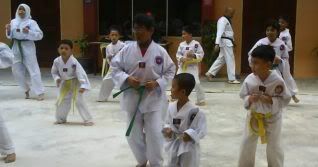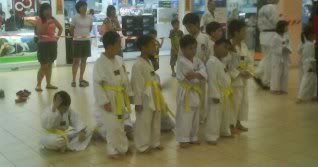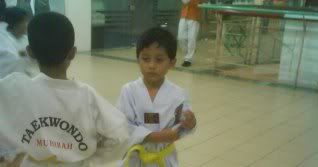A.... is for Attentive. Taekwondo kids are very attentive.
For them to learn complicated taekwondo kicks and moves. They must concentrate hard. By being attentive and focus, their attention span gets longer. And longer.
They learn to be still. And really listen. And of course their school teachers welcome the change!
B.... is for Behavior. Good Behavior.
Kids in taekwondo learn great taekwondo principles. Like courtesy,respect the eldest and self-control. They learn to behave well in the taekwondo dojang. And in life too.
C.... is for Confident. Kids training in taekwondo become confident.
 Image by Taekwondo Kids Store via Amazon
Image by Taekwondo Kids Store via Amazon
As they strive to reach the goals. Perform taekwondo patterns in front of the class. And break through wooden boards.
We will see self-confidence grow slowly inside them. They start to believe in themselves. And it shines through in everything they do. They walk with their heads high. Speak clearly in front of the class. And chat easily to grown-ups.
D.... is for Discipline. There's two parts to this.
Firstly - Taekwondo kids learn to do as they are told. They come to understand that if they want to get better. And do great taekwondo kicks. They have to be quiet. And listen. And follow the instructions they are given.
Secondly - Children in taekwondo also learn self-discipline. They learn that if they want to be good at taekwondo. Or anything worthwhile but difficult. They have to push themselves. And focus.
They have to turn up for training. Every week. And give their best.... Even when they don't feel like it.
E.... is for Energy. Kids have so much of it.
They can run and play all day. And still be up for a game of football in the evening.
We love to see taekwondo kids using this energy. And putting it to good use. And getting great results.
F... is for Fitness.
Training in taekwondo gets kids fit. They run, jump, kick and punch. They do push-ups and sit-ups. And they stretch and stay flexible. And benefit from all round taekwondo fitness.
G....is for Gentle.
Being gentle is a hugely important part of martial arts.
The best taekwondo instructors are gentle. And in turn their students learn to be gentle. And patient. Especially when teaching younger kids.
H.... is for Happy!
If you watch a taekwondo class. You'll see happy kids. They just love it!
I.... is for Individuals.
Kids in taekwondo learn that everyone is different. That everyone learns at their own pace. And that everyone is good at something.
They learn to respect themselves as individuals. For who they are. And to respect their class-mates. For who they are.
J.... is for Justice. Peace and Justice.
Taekwondo kids are encouraged to become champions of peace and justice. Young people who stand up for what's right. And help the weak. Even if this doesn't make them popular at the time.
K....is for Kicks! Cool Kicks!
Taekwondo is a kicking martial art. And kids in taekwondo quickly learn the basics. Then move on to do fabulous spinning and jumping kicks. Which are great fun to watch. And great fun to do. And because they are kids. They can really throw themselves into their techniques. Because when they fall they don't hurt themselves. (Of course we're not jealous! Well maybe a little!)
L....is for Like. Taekwondo Kids Like themselves.
Taekwondo helps kids to get fit. And feel and look healthy and well. And taekwondo kids work hard to achieve tough goals. And are proud of what they achieve.
All this helps kids to think good things about themselves. Which builds self-esteem.
M....is for Motivated.
Kids in taekwondo become motivated to do well. To achieve their goals. To be as good as the great role-models they train with.
N....is for nurtured.
We see great taekwondo instructors and senior students really nurture the kids in their classes. Support them through difficult times. And be really proud of their successes. And in turn,kids in taekwondo learn to nurture their younger peers.
O....is for opportunity.
There are fantastic opportunities out there for kids in taekwondo. They can learn to teach. And test themselves in competitions. They can travel overseas for seminars. Or training tours. See a bit of the world. And learn about other cultures. Which will broadens their horizons. They can meet great people. Fit, healthy, motivated people. Fantastic people for children to be around.
P...is for Perseverance.
Taekwondo kids know the power of perseverance. They learn that if they want to succeed. Taekwondo is rather difficult (sometimes) but worthwhile.
Then they'll have to keep trying. And face failure. And not give up when things are hard. But keep on and on trying and trying. Until... They get there!
Q....is for Quiet. We've noticed that kids in the taekwondo learn how to be quiet. How to stop talking. And how to sit quietly and listen. And be open to new ideas.
R....is for Respect. A huge part of martial arts training. Taekwondo kids learn to respect their instructor. Their martial art. Their fellow students. And themselves.
S....is for Self-control. Taekwondo kids learn powerful techniques, and they also learn about self-control. They learn never to misuse their taekwondo.
At first this is because their instructor tells them not to. But in time they realise they don't need to. Because as kids train in taekwondo, become more confident in themselves. And more peaceful inside. So they find there is no need to lose control. And shout. Or kick. Or punch.
T....is for Tough!
Taekwondo kids become tough! They face tough challenges in their training. Like full-contact sparring. Where they have to come through fear. And take a few knocks. And get back up. And keep going.
This prepares them for life... Which as we all know...Is tough!
U....is for United.
Kids in taekwondo become strong, united teams. As they train together. And support each other. They learn about teamwork. And they learn that by working as a team. They can achieve more. Much, much more. Than they ever could on their own.
V....is for Very Very Calm.
A definite calmness descend on taekwondo kids. They become happy. And peaceful in their own skins. With a quiet assured self-confidence. It's lovely to see.
W....is for Wise. Street-Wise.
Through taekwondo self defense training, kids learn about dangerous situations. They learn how to stay out of trouble. And avoid arguments. And they learn good ways to deal with confrontation. How to diffuse other peoples' anger without backing down. And how to defend themselves if they really have to.
X....is for eXcellence!
Being good at something. Striving to be the best you can be. And lots of kids in taekwondo reach fantastic heights.
This is especially important for kids to have something worthwhile that they excel at. This will make them feel proud of themselves and their achievements
Y....is for Yes!
Kids in taekwondo learn to say Yes. They learn to take on new challenges. Try new things. Push themselves out of their comfort zones. And in doing so. They keep growing!
Z....is for Zest. Zest for life!
Brilliant to see in taekwondo kids of all ages! Even the grown up ones!
 Image via WikipediaMy instructor was lecturing me about the importance of our Taekwondo sparring drills. I enjoyed the drills just as much as everyone else in the dojo, but I was not sure where my instructor was going with this particular lecture. Her large, attentive eyes made contact with mine as they always do. She was just a little shorter than me (and I'm short), but she was an experienced black belt with a lot of skill in Taekwondo. I always enjoyed listening to her lectures, especially when she was speaking to only me.
Image via WikipediaMy instructor was lecturing me about the importance of our Taekwondo sparring drills. I enjoyed the drills just as much as everyone else in the dojo, but I was not sure where my instructor was going with this particular lecture. Her large, attentive eyes made contact with mine as they always do. She was just a little shorter than me (and I'm short), but she was an experienced black belt with a lot of skill in Taekwondo. I always enjoyed listening to her lectures, especially when she was speaking to only me.












